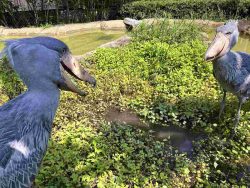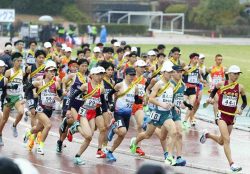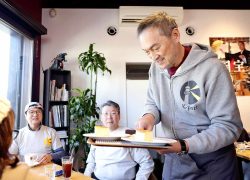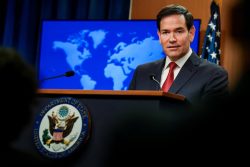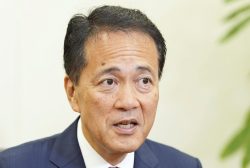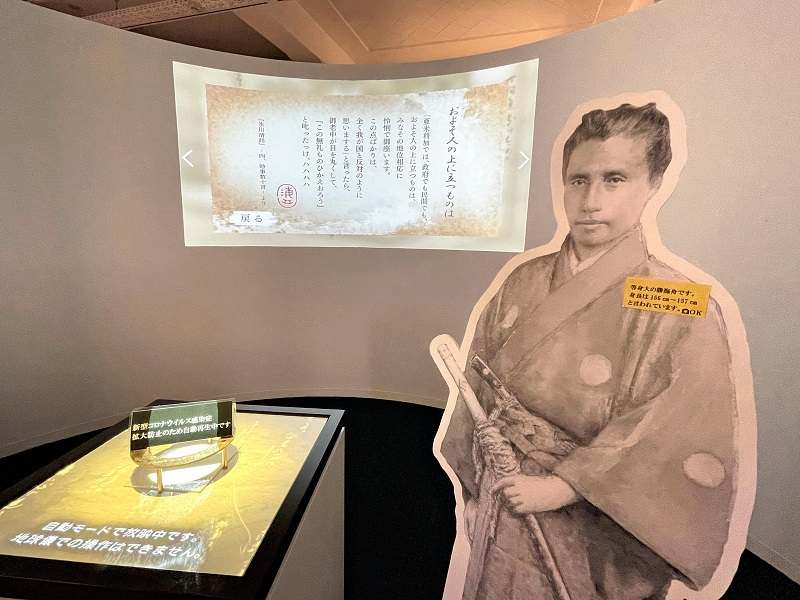
Quotes from Katsu are projected on the wall in the “Kaishu’s Brain” exhibit.
14:53 JST, May 5, 2021
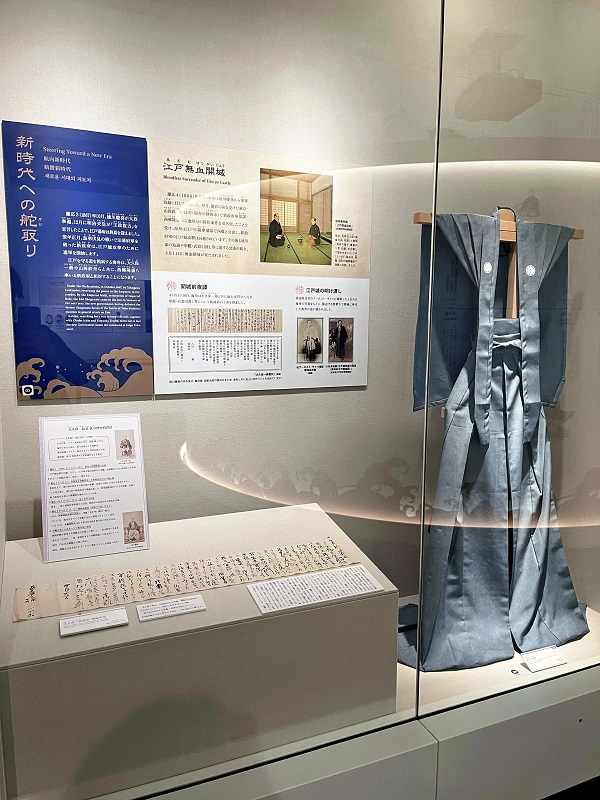
A replica of the hakama pants Katsu wore for his meeting with Saigo Takamori regarding the surrender of Edo Castle is on exhibit. The letter Katsu exchanged with Okubo Ichio prior to the meeting is seen to the left.
The Ota City Katsu Kaishu Memorial Museum opened in 2019, commemorating the 120th anniversary of the death of former samurai-turned-politician Katsu Kaishu (1823-1899), a key figure in the bloodless surrender of Edo Castle.
Katsu represented the Tokugawa shogunate in the 1868 talks with Saigo Takamori, the representative of the new Meiji government. Katsu was a late bloomer to reach such a social status.
When U.S. Commodore Matthew Perry called for the opening of Japan’s borders in 1853, the Edo shogunate sought opinions from feudal lords over the pros and cons of such a step. Katsu, 31 at the time, proposed an open-country policy.
Based on a series of experiences, including training at the Nagasaki naval institute and a voyage across the Pacific on the Kanrin Maru ship, Katsu pursued republicanism among the Tokugawa, Satsuma and Choshu clans. However, the tables were turned when political authority changed hands from the shogunate to the emperor and imperial rule was restored. Katsu became increasingly busy negotiating with the new government, which was about to stage a major attack on Edo Castle.
The first floor of the museum takes visitors through the Katsu’s life with an assorment of charts and documents that vividly show the fierce clash between the shogunate and the government.
One item on display is a letter from Okubo Ichio, who was also a leading figure in the bloodless surrender, asking Katsu’s opinion on what to do with shogunate-owned warships upon a request by the government to hand them over, as well as over the treatment of the last shogun, Yoshinobu.
In an exhibit titled “Kaishu’s Brain,” some of his words of wisdom are projected on a wall. The quotes are taken from a number of sources including a collection of Katsu’s discourses given in his later years of life called “Hikawa Seiwa.”
In those archives, Katsu shared his evaluations of others, describing Saigo as “a gentle man with a kind face,” and his philosophy on life as he wrote, “If you are persistent, even your enemies will be overwhelmed and eventually become your allies.”
On the other hand, Reo Hoshikawa, 35, a curator at the museum, pointed out, “He was criticized by shogunate aides for selling out his lord.”
Katsu faced backlash from those close to the shogunate, such as Fukuzawa Yukichi, over his handling of the bloodless surrender and his bold words, but Hoshikawa sees Katsu as “an unconventional and flexible person.”
The second floor showcases a diorama of Katsu’s villa Senzokuken. Visitors can delve deeper using a tablet that projects augmented reality animation on the diorama, showing details of the villa’s interior.
There is also an exhibit with a quiz about Katsu, featuring questions on a number of subjects including the official name of a written opinion sent from Katsu to the shogunate as well as his height and favorite food. After all of the questions have been answered, Katsu appears on the screen and gives users a thumbs-up or down based on their result.
Ota City Katsu Kaishu Memorial Museum: 2-3-1 Minami-Senzoku, Ota Ward, TokyoRelated Tags
"Features" POPULAR ARTICLE
-

Sanrio to Open Museum in Yamanashi Pref. Dedicated to Founder, Exhibits Include Hello Kitty, Other Characters
-

Autumn Foliage Surrounds Visitors to Tokyo’s Showa Kinen Park
-

My Daughter No Longer Speaks to Me, But I Want to See Her and My Grandchild
-

Kumamoto: Public Bath Refurbished as Library Where You Can Chat, Take Photos
-
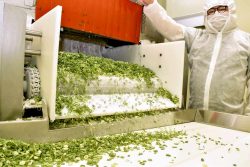
Frozen Vegetables: Demand Rises for Convenient, Tasty Domestic Produce
JN ACCESS RANKING
-

Keidanren Chairman Yoshinobu Tsutsui Visits Kashiwazaki-Kariwa Nuclear Power Plant; Inspects New Emergency Safety System
-

Imports of Rare Earths from China Facing Delays, May Be Caused by Deterioration of Japan-China Relations
-

Tokyo Economic Security Forum to Hold Inaugural Meeting Amid Tense Global Environment
-

University of Tokyo Professor Discusses Japanese Economic Security in Interview Ahead of Forum
-

Japan Pulls out of Vietnam Nuclear Project, Complicating Hanoi’s Power Plans



